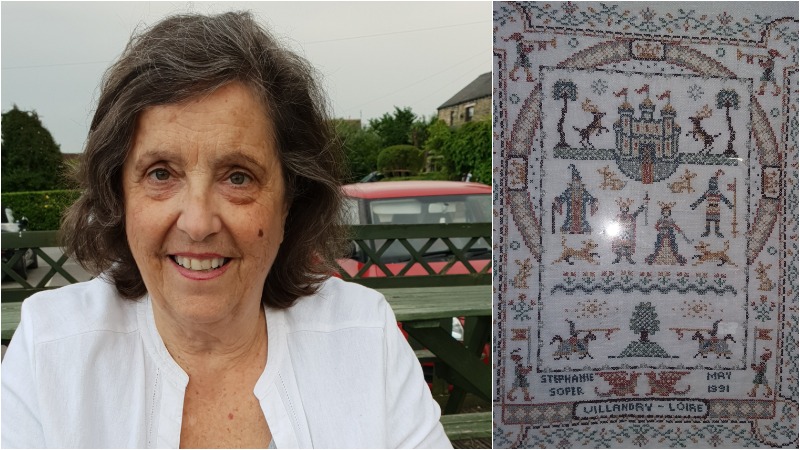Stephanie still keeps her very first work, a needle case which she made when she started school aged four. The case is now quite worn and faded, but making it lit that very first spark that ignited her passion for embroidery.
Colours have always been very important to Stephanie. “It might be hereditary,” she says. Her grandfather, who could identify 64 shades of black, was director of the British Dyers Association and the world expert in dyeing black cloth for Muslim countries.
When she was eight, he gave her a large box of embroidery silk, each hank as thick as an arm in every shade imaginable. Out of these, her favourite colour was purple. There were ten shades of it, ranging from pale lavender to deep mauve.
“Imagine the usual skein of a small rack of silk you might see hanging on hooks in a haberdashery,” says Stephanie. “Now multiply this by the size of an elephant and you’ll visualise it.”
The box was one of the most amazing presents Stephanie received in her life, and some 60 years later, she still has some pieces of silk left. Her father in fact hated the dyeing industry, so maybe the passion skipped a generation and affected her instead.
Later, Stephanie’s faith in God led her to ecclesiastical embroidery, and she’s been devoted to it ever since. Her masterpiece was a priest’s stole which she sewed for her local vicar – a complicated piece on cream silk topped with a St. Catherine’s wheel above flames and under a cross intertwined with scroll work. It had lots of gold couch work in the highlights. (This is where thin metallic threads are held onto the cloth with tiny side stitches in fine strands of silk or cotton. They can be built up into different widths.) The same stole is now used in her family for religious occasions.
Stephanie also made a reversible tri-stole for another vicar. On the green side was a sheaf of corn in gold leather surrounded by copper-coloured vine leaves and pea-sized grapes of a black sparkling thread called Twilleys Lyscordet. It represented the bread and the wine for communion.
On the purple reverse side, she copied stained glass windows from the church. (The Church of England’s seasons are red, white, green or purple depending on the time of the year). When she was creating the green side of the stole, she remembered feeling great passion for this piece – a true labour of love. Upon finishing it, she was tired as her energy had drained out into the work.
As her talent grew, Stephanie started to restore antique embroidery too. She thinks it a privilege to restore old pieces that others have worked on such a long time ago, when lighting and technology were relatively primitive. She appreciates those antiques as if they had lives.
Every step of such restorations demands careful thought and imaging the craftsmen of the time, whether their level of craftsmanship was high or low, whether their attitude was cautious or perfunctory. To restore antique embroidery is to start a dialogue with the makers of past generations. Like folk songs, the antiques carry the joys and sorrows of the past. These artefacts contain a vast amount of historical information preserved from generation to generation.
Restoration should be both traditional and innovative, according to Stephanie. With a broad perspective, she communicates with foreign peers, historians and researchers. Even for a simple repair, the modern reference system is different from the past. Stephanie’s hands witness her daily conversations with these treasures of old.
Centuries later, when Stephanie is giving a second life to these antiques, she infuses them subtly with her own personal touches. When she has finished restoring a piece, she leaves a little dedication sheet hidden in the lining as her reward for the work. If the piece is restored again, future generations will find the sheet and know more about what life was like in her time.
Stephanie’s hardest restoration job of all was a funeral pall at Holy Trinity Church in Nice made in about 1880. When the back side was removed, the interior was full of black soot – a rather dangerous thing to work on. It took a long time for her to finish as there were no shortcuts possible. But Stephanie believes that the best craftsmanship involves the gift of time. The world of the restorer is quiet and honest. The right craftsmanship requires sincerity and faith, sinking into space and time.
Stephanie has been an adviser to York Minister, a treasured cathedral in the UK which has a collection of old Chinese robes in its vaults. She headed up a fashion show of embroidered Chinese imperial robes from the late Ching dynasty (1800-1920) at Carlton Towers, home of the Duke of Norfolk, and at the Antiques Seminar of Great Britain in Harrogate.
For amateur embroidery lovers, Stephanie suggests choosing something comfortable, useful and simple. More difficult accomplishments can follow later. Pick the style, colours and function. Her admonition is to “pass on your talent to your children and inspire them to follow your tradition. It’s a perfect antidote to smartphones and the internet.”
For more information, email Stephanie directly at sth1000@hotmail.com








